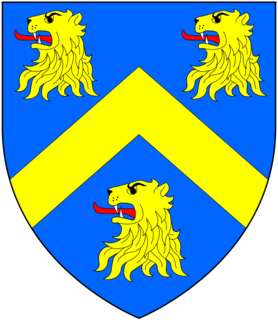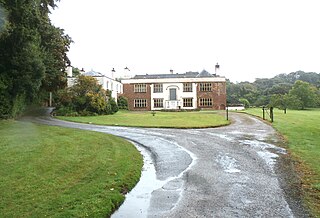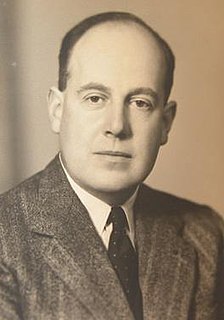
Horatio Walpole, 4th Earl of Orford, better known as Horace Walpole, was an English writer, art historian, man of letters, antiquarian and Whig politician.

John Howard, 1st Duke of Norfolk, was an English nobleman, soldier, politician, and the first Howard Duke of Norfolk. He was a close friend and loyal supporter of King Richard III, with whom he was slain at the Battle of Bosworth in 1485.

Felbrigg Hall is a 17th-century English country house near the village of that name in Norfolk. Part of a National Trust property, the unaltered 17th-century house is noted for its Jacobean architecture and fine Georgian interior. Outside is a walled garden, an orangery and orchards. The house and grounds were bequeathed to the National Trust in 1969 by Robert Ketton-Cremer. The hall is Grade I on the National Heritage List for England. Most of the grounds are part of Felbrigg Woods, a Site of Special Scientific Interest.

Sir William Calthorpe KB was an English knight and Lord of the Manors of Burnham Thorpe and Ludham in Norfolk. He is on record as High Sheriff of Norfolk and Suffolk in 1442, 1458 and 1464 and 1476.

Sir Miles Stapleton, KG was Lord of the Manor of Ingham, Norfolk and de jure Baron Ingham of Ingham, Norfolk, and Lord of the Manor of Bedale, Yorkshire.

General Sir John Dalling, 1st Baronet was a British soldier and colonial administrator.

Sir John Wyndham, JP, of Orchard Wyndham in the parish of Watchet in Somerset, was an English landowner who played an important role in the establishment of defence organisation in the West Country against the threat of Spanish invasion.
This is a list of Sheriffs of Norfolk and Suffolk. The Sheriff is the oldest secular office under the Crown and is appointed annually by the Crown. He was originally the principal law enforcement officer in the county and presided at the Assizes and other important county meetings. After 1576 there was a separate Sheriff of Norfolk and Sheriff of Suffolk.

There have been three Wyndham Baronetcies, all created in the Baronetage of England. All were created for descendants of Sir John Wyndham (d.1573) of Orchard Wyndham in the parish of Watchet, Somerset, by his wife Elizabeth Sydenham, daughter and co-heiress of Sir John Sydenham of Orchard Sydenham. He was a grandson of Sir John Wyndham of Felbrigg, Norfolk, by his first wife Lady Margaret Howard, 4th daughter of John Howard, 1st Duke of Norfolk.

Thomas de Morley, 4th Baron Morley, KG was a baron in the Peerage of England, Lord of Morley, Hingham, Hockering, &c., in Norfolk, de jure Lord Marshall, hereditary Earl Marshal of Ireland, and a Privy Councillor. He was summoned to parliament from 20 October 1379 to 3 September 1416.

Orchard Wyndham is a historic manor near Williton in Somerset, centred on the synonymous grade I listed manor house of Orchard Wyndham that was situated historically in the parish of Watchet and about two miles south of the parish church of St Decuman's, Watchet. Parts of the manor house are medieval. It has been owned for more than 700 years by the prominent Wyndham family, who continue there as of 2015.

The de Walcott family were Lords of the Manor of Walcott England from the late 12th century until the late 14th century.

Oxnead is a lost settlement in Norfolk, England, roughly three miles south-east of Aylsham. It now consists mostly of St Michael’s Church and Oxnead Hall. It was the principal residence of the Paston family from 1597 until the death of William Paston, 2nd Earl of Yarmouth in 1732. Under Sir William Paston (1610–1663), Oxnead was the site of several works by the architect and sculptor, Nicholas Stone, master-mason to Kings James I and Charles I.
William Howe Windham was the son of Vice-Admiral William Lukin Windham, and a British Member of Parliament. He lived at Felbrigg Hall.

Sir John Wyndham of Orchard Wyndham in the parish of Watchet, Somerset, was born a member of a prominent gentry family in Norfolk and founded his own prominent gentry family in Somerset, which survives today at Orchard Wyndham.

Robert Wyndham Ketton-Cremer, was an English landowner, biographer and historian. He bequeathed his family seat, Felbrigg Hall, to the National Trust.

William Frederick Windham was the son of William Howe Windham and the heir to Felbrigg Hall in the county of Norfolk, England. In 1861–62, he was the subject of a "lunacy" case after he married a woman of whom his uncle did not approve, causing his family to claim that he was incapable of managing his affairs. Windham won the case in a ruling that characterised him as eccentric rather than a lunatic.

Beeston Hall School is an independent day and boarding preparatory school for boys and girls in the village of Beeston Regis, Norfolk. Founded in 1948, Beeston Hall currently accommodates 125 pupils aged 4 – 13 making it the largest boarding preparatory school in East Anglia.

Ashe Windham, of Felbrigg, Norfolk, was an English landowner and politician who sat in the House of Commons from 1708 to 1710.
Sir Thomas Wyndham of Felbrigg was an English sea captain and Vice-Admiral of England.




















